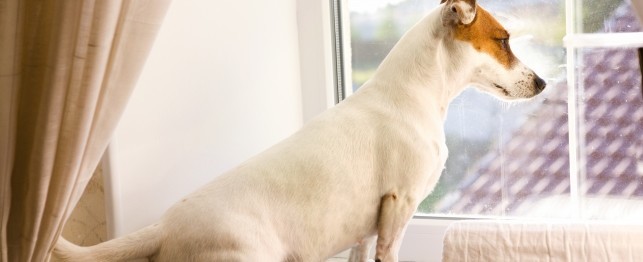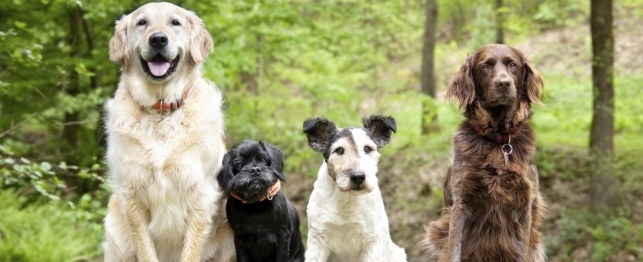

Dogs
For many people, a dog is the perfect and final complement to a house with a yard. Many breeders, in fact, make a "fenced yard" a prerequisite before they would even consider placing one of their puppies with you. But those of us who live in apartments love dogs too, and while we don't see a house with a yard in our immediate future, we really do want a dog in our lives.
It is possible to love a dog in an apartment. It just takes a little more work, and it starts with choosing the right kind of dog.
Some breeds do better in apartments than others, and remember: size isn't always the determining factor. Many small dogs - terriers and beagles among them - are very high-energy dogs who like to move around and run for most of the day, and are likely to be problem barkers. Several large breeds, on the other hand - Great Danes and mastiffs, for example - will happily hang out on the couch or carpet for most of the day, so long as you give them their daily dose of exercise. Research the breeds in which you are interested carefully. Do not get a dog that authors describe as "prone to cabin fever" or "hates to be confined." Neither of you will be happy in a two-bedroom apartment.
Unfortunately, the non-dog people who own your apartment building or run your condo board may wrongly think all small dogs are good apartment inhabitants and all big dogs completely inappropriate. You may need to invest some time in educating them. If you have to fill out a formal pet request, include some photocopied pages from books or articles extolling the virtues of your breed of choice as an apartment dweller.
Try to find an apartment near a green area, pleasant pathways, park or a dog run - you cannot afford to be lazy about the exercise you give your apartment dog. Spend some time walking around your potential new neighborhoods and keep an eye out for dogs. Numerous dogs are a sign of a dog-friendly neighborhood. Evaluate the traffic, too: are there a lot of overpasses at which you'll be risking your lives every time you cross?
I invest a lot of time in investigating new neighborhoods before making a decision. When renting, I also ask if dogs are allowed after otherwise impressing the landlord with what a wonderful tenant I will make.
If you're getting a dog to fit an apartment you already have, be honest and critical of your surroundings. There are certain environments in which no animal will be happy. Of course, chances are, you wouldn't be too happy there either.
Ideally, you want to live in a dog-friendly building in which everyone loves your dog almost as much as you do. That will not always happen. However, whatever the other tenants feel, the landlord must love your dog. The landlord must know that your dog is sweet, gentle and well-behaved. Teach the dog to respond to the landlord with his nicest doggie manners. Give the landlord treats to feed to your dog. Regardless of how wonderful your dog is, there will be people in your building who dislike her on principle. Work to get the landlord on your side.
Introduce your dog to your immediate neighbors upon moving into a new building. Knock on doors and introduce yourself and your dog. "We've just moved in next door, and I wanted you to meet my dog, so that she knows you and you know her." If you meet other dogs on this walk-about, offer your services as an emergency dog walker, as in: "If you ever need me to take your dog out when I walk with my dog, just let me know." You might get some reciprocal offers in return. In an apartment situation, it is crucial to have an emergency arrangement in which your dog is taken care of in case you're away from home longer than you had anticipated. There is no doggie door to the backyard or garage.
You learn very quickly who likes dogs and who is terrified of them and, for the sake of happy communal living, you have to respect the fears of the latter. Before getting on an elevator, ask if everyone is all right with your dog coming on. Remember who turns white and starts palpitating at the sight of you and your canine companion, and hold your dog a little closer when you pass them by. It's tempting to try to cure people of their unreasonable dog phobias-don't. Accept them. It's unlikely such people will ever learn to love your dog, but they will like and respect you.
Sharing your life with a dog is a big and important decision wherever you live. However, if you're an apartment dweller about to recruit a four-legged roommate to share your 18th floor loft, you must recognize that your commitment is just a little more intense than that of your house-dwelling neighbor. You can't be lazy and, instead of going for your daily walk, romp around with puppy in the backyard. You have to accompany him. However suited to apartment living your dog is, cabin fever will eventually set in if you neglect him.
Letting your dog out in the morning is not just a question of opening the back door - it's a major production. You must get dressed, or at least throw a coat over your pajamas, waddle to the elevator, take it down and then brave the elements while your dog does her business. Same goes for the occasional 3 a.m. emergency.
That, by the way, is when you realize just how much you love your dog: when that wet nose touches your cheek and that tiny little voice whines and lets you know that she's been holding it as long as she could, but that bran muffin she stole that morning ... well, you were right about it being bad for her, and you, half-awake, struggle out of bed without a second thought, get your coat and boots and trek to the elevator with the love of your life in tow.
 Nick Names for Common Dog Breeds
Nick Names for Common Dog Breeds
Nick Names for Common Dog Breeds
Nick Names for Common Dog Breeds
 10 Tips to Avoid Online Dog Adoption Scams
10 Tips to Avoid Online Dog Adoption Scams
10 Tips to Avoid Online Dog Adoption Scams
10 Tips to Avoid Online Dog Adoption Scams
 Top Dog Breeds for Seniors
Top Dog Breeds for Seniors
Top Dog Breeds for Seniors
Top Dog Breeds for Seniors
 How to Select the Right Family Dog
How to Select the Right Family Dog
How to Select the Right Family Dog
How to Select the Right Family Dog
 Buying a Dog - Tips on How to Select the Right Dog
Buying a Dog - Tips on How to Select the Righ
Buying a Dog - Tips on How to Select the Right Dog
Buying a Dog - Tips on How to Select the Righ
Copyright © 2005-2016 Pet Information All Rights Reserved
Contact us: www162date@outlook.com